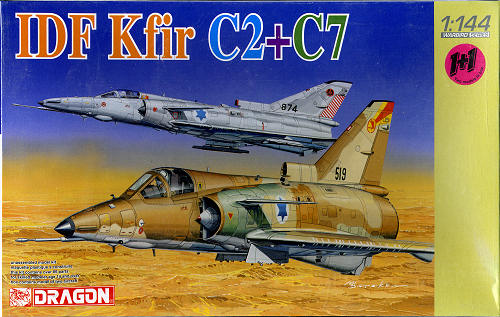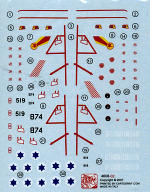
Dragon 1/144 Kfir C2/C7
| KIT #: | 4608 |
| PRICE: | $7.65 from www.greatmodels.com |
| DECALS: | 2 options |
| REVIEWER: | Scott Van Aken |
| NOTES: | Two complete kits |

| HISTORY |
The project that would ultimately give birth to the Kfir can be traced back to Israel's need for adapting the Dassault Mirage IIIC to the specific requirements of the Israeli Air Force (IAF).
The all-weather, delta-winged Mirage IIICJ was the first supersonic aircraft acquired by Israel, and constituted the backbone of the IAF during most of the 1960s, until the arrival of the A-4 Skyhawk and, most importantly, the F-4 Phantom II, by the end of the decade. While the Mirage IIICJ proved to be extremely effective in the air-superiority role, its relatively short range of action imposed some limitations on its usefulness as a ground-attack aircraft.
Thus, in the mid-1960s, at the request of Israel, Dassault Aviation began developing the Mirage 5, a fair-weather, ground-attack version of the Mirage III. Following the suggestions made by the Israelis, advanced avionics located behind the cockpit were removed, allowing the aircraft to increase its fuel-carrying capacity while reducing maintenance costs.
By 1968, Dassault had finished production of the 50 Mirage 5Js paid for by Israel, but an arms embargo imposed upon the country by the French government in 1967 prevented Dassault from ever delivering the aircraft. The Israelis replied by producing an unlicensed copy of the Mirage 5, the Nesher, with technical specifications for both the airframe and the engine obtained by Israeli intelligence.
The development of this aircraft has been attributed to covert action on the part of Mossad. Mossad was able to acquire the plans for the Mirage III, which were used directly in the design process of the Kfir aircraft series. The designers at IAI then began work on the project to improve upon the Mirage III, deciding first to find a replacement engine.
Two powerplants were initially selected for trials—the General Electric J79 turbojet and the Rolls-Royce Spey turbofan. In the end, the J79 was selected, not the least because it was the same engine used on the McDonnell Douglas F-4 Phantom II, which the Israelis began to acquire from the United States in 1969, along with a license to produce the J79 themselves. The J79 was clearly superior to the Atar 09, providing a dry thrust of 49 kN (11,000 lbf) and an afterburning thrust of 83.4 kN (18,750 lbf).
In order to accommodate the new powerplant on the Mirage III's airframe, and to deliver the added cooling required by the J79, the aircraft's rear fuselage was slightly shortened and widened, its air intakes were enlarged, and a large air inlet was installed at the base of the vertical stabilizer, so as to supply the extra cooling needed for the afterburner. The engine itself was encased in a titanium heatshield.
A two-seat Mirage IIIBJ fitted with the GE J79 made its first flight in September 1970, and was soon followed by a re-engined Nesher, which flew in September 1971.
An improved prototype of the aircraft, with the nameRa'am ("Thunder"), made its first flight in June 1973. It had an extensively revised cockpit, a strengthened landing gear, and a considerable amount of Israeli-built avionics. The internal fuel tanks were slightly rearranged, their total capacity being increased to 713 gallons.
There were unconfirmed reports that a number of the original Mirage IIICs, re-engined with the J79 and given the name Barak ("Lightning"), took part in the Yom Kippur War of 1973, but some sources point out that there is no real evidence that these aircraft ever existed.
The Kfir entered service with the IAF in 1975, the first units being assigned to the renowned 1st Fighter Squadron. Over the following years, several other squadrons were also equipped with the new aircraft. The role of the Kfir as the IAF's primary air superiority asset was short-lived, as the first F-15 Eagle fighters from the United States were delivered to Israel in 1976.
The Kfir's first recorded combat action took place on November 9, 1977, during an Israeli air strike on a terrorist training camp at Tel Azia, in Lebanon. The only air victory that the Kfir achieved during its service in the IAF occurred on June 27, 1979 when an Israeli Kfir C.2 shot down a Syrian MiG-21.
By the time of the Israeli invasion of southern Lebanon in 1982 (Operation Peace for Galilee) the IAF was able to use both its F-15s and F-16s for air superiority roles, leaving the Kfirs for carrying out unescorted strike missions. Soon after all the IAF's C.2s began to be upgraded to the C.7 version, which enhanced the performance of the aircraft as a fighter-bomber, the Kfirs' new role in the IAF's order of battle.
During the second half of the 1990s, the Kfirs were withdrawn from active duty in the IAF, after almost twenty years of continuous service.
| THE KIT |
 This 2007 boxing includes two full kits with options to build either a C2 or C7 variant of the Kfir. As it is 1/144, there are not a ton of parts, but those provided are well molded. The engraved detailing is a bit overdone for this scale, but is typical of standard injection molded kits.
This 2007 boxing includes two full kits with options to build either a C2 or C7 variant of the Kfir. As it is 1/144, there are not a ton of parts, but those provided are well molded. The engraved detailing is a bit overdone for this scale, but is typical of standard injection molded kits.
The cockpit is a single piece with a pilot figure in a generic seat. Landing gear are well molded and as the doors are molded in the closed position, one could do this kit in flight if one wished to build a stand. The only real difference between a Kfir C2 and C7 is the size of the intake mounted canards. On the C2 they are much smaller than on the C7. If one wished to do an F-21A from this kit, one would choose the smaller canards. The small canopy is thick and well molded.
real difference between a Kfir C2 and C7 is the size of the intake mounted canards. On the C2 they are much smaller than on the C7. If one wished to do an F-21A from this kit, one would choose the smaller canards. The small canopy is thick and well molded.
The set includes a sprue of weapons that include laser-guided bombs and some missiles, however, none of these parts are mentioned at all in the instruction sheet. Any of these would be appropriate for either variant. The instructions are really just two small construction steps with a full page for each of the two options. You can do one aircraft in the later greys scheme or one in the earlier desert camouflage. I have to assume that the C2 in IAF service was later upgraded to the larger canards as the C2 option (the one in greys), has the larger C7 canards. The small decal sheet is well printed and offers a full array of warning and data markings.
| CONCLUSIONS |
It is great to see these aircraft being kitted. An interesting choice to be sure, especially when one could do several dozen different boxings if this were a Mirage III/V kit instead. It may well be possible to backdate the Kfir to a Mirage III/V, but will not be all that easy thanks to the larger fuselage to handle the Kfir's J-79. Regardless, a neat kit and one that not only should be fairly quick to build, but should look great on one's display shelf.
| REFERENCES |
October 2008
You can get this kit as well as others and a raft of accessories at GreatModels
If you would like your product reviewed fairly and fairly quickly, please contact the editor or see other details in the